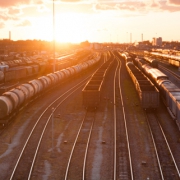Why some trading and smart contracts don’t make LNG hubs yet
Everyone who has touched upon trading – as the term is understood today – very quickly falls victim to the impression that this casino is the real economy. And that indices, charts, KPIs, and financial market performance are all that matters. It does not take long and the virtual world has you in its clutches.
Losing touch with reality is just a logical next step which means that forgetting the basics of the basics is not an alien thing to you anymore.
Why do I say this?
Ever since I joined the LNG roadshow, the first LNG hub seemed to be just around the corner, and somehow – they did not spring into existence yet. Not really at the least.
For more than 15 years some of the biggest players in the industry tried to make LNG a true commodity and lots of phony successes have been announced just to disintegrate into what all those announcements always were – hot air.
But now, the core ingredients for the first real LNG hub are mixed up – quite inadvertently so – and in a region of the world where nobody expected it to spring up. No matter what you do in LNG – you won’t be able to ignore what happens in North Western Europe for long. Japanese utilities and South American buyers, portfolio players and Middle Eastern producers, Australian Megaprojects, and US shale gas drillers. They all will have their eyes fixed on the European sink as it will provide balance to the market.
And considering how jagged the LNG marketplace is going to be for the next decade or so, balance providers will be priceless.
What are we learning from all this? Despite all the banter, efforts, hype, and strong-arming by other wannabe LNG hubs, it’s not the smart contracts that make a hub but rather the physical ability to swallow LNG and spew it back into the market that whips the cream. And none of the wannabes ever had that capability.
Let’s take a peek at two of the more famous would-be contenders.
Qatar had a strong claim to become the first LNG hub. They are still in the big boys club even as Aborigine LNG makes a big splash this year, and they thought that a combination of big volumes without a destination straight jacket, a large fleet of super large vessels, a geo-strategic position between Asia and the Atlantic markets and some smart contracting on top of an integrated facility will win them the day. The problem is that Qatar still produces LNG at nameplate capacity or something similar to that. Their tanks are their only claim to flexibility and no matter how big they are, they will have to evacuate rather quickly into vessels as otherwise, they bust tank tops and facilities will have to curb production if tanks are not emptied. They cannot take LNG out of the market or give it back at will as their operational production profile dictates their output and not the needs of the markets.
Another example is Singapore which wants to leverage its strategic position, brand-new LNG regasification terminal, and flexible terminal scheme on top of some smart contracting is supposed to win them the crown. But Singapore is even more constrained than Qatar is. Put one cargo too much into the terminal, and they must call it quits quicker than a drop of water evaporates on the surface of the sun. How many cargoes could the terminal make available for back-loading if such is required at short notice? Possibly not even one.
LNG is very much a physical market. This means that most done deals correspond to some real LNG that exists somewhere. Years ago I asked if LNG was a commodity. I denied this status at the time as it was unclear how anyone – who does not have contingent capacity available over the entire chain – would unwind a cargo in distress. Crude cargoes can be unwound at any time no matter where the physical oil is located at any time as there is plenty of spare capacity on the world market to swallow and produce one more cargo. This can be repeated almost at will as the market is gigantic. It will only drive prices up and down but the flow of oil would not quiver.
LNG is still too small and unimportant yet to have such overcapacity built up although those things start to change very slowly. Not Qatar, not Singapore nor any lesser wannabe would bring even a bit of flexibility to players in distress.
Let’s compare this with some gas hubs. In the US, Henry Hub reigns supreme and what defines Henry Hub? The ability to exchange gas at a place where huge storage capacities and the crossing of multiple pipelines allow for all kinds of flexible deals. HH can absorb gas when it’s not needed and supply gas when it’s needed. The same holds for TTF – to a lesser degree for NBP as storage is paltry in the UK.
A hub, any hub, is not defined by the volume of product flowing through it but rather by the services it can provide to a meaningful segment of the market. Tunisia is the most important gas transit country for Algerian pipeline gas to Europe as Transmed runs through it. Volumes are very large – is Tunisia a gas hub though? The services it can provide to this stream of gas are virtually nil, though. Gas that goes into Tunisia leaves Tunisia as is – no value added. No hub here then.
Let’s look at Turkey as another one. Turkey is a significant market in itself and would be a major user of gas that went through its territory but they cannot provide balance to the vagaries of the market downstream of Turkey (South Eastern Europe) and/or the base-load volume balancing stability, producers would find valuable. As much as they would like to pretend that they would be a hub, they would only take what they get from one side, slap a fee on top, and resell as is.
A hub alters the product it trades from something less valuable into something more valuable. I will deliver you base-load gas for 1 year on an even delivery profile with 100% Take or Pay is not a premium product. I will give you gas exactly when you need it and as much as you need every day – provided you pay for it – is vanilla.
Ukraine, for that matter, would theoretically provide the fundamentals for a very interesting hub for Russian gas into Europe as it is a big market in itself and it provides plenty and deep storage capacity allowing the structuring of gas deliveries into major European markets.
Stored summer gas from Ukraine will be worth more when delivered at peak use in winter than simple base-load summer gas delivered if the market needs it or not.
Strictly speaking, Ukraine is not a gas hub and the very difficult political situation with Russia makes it even less so but it could have been a meaningful hub. Too bad.
Let’s come back to LNG and let’s start with clearing up some misconceptions about an imagined future LNG hub:
Misconception 1: An LNG hub can just exist where there is a lot of LNG!
Volume is not important, the ability to absorb unwanted cargo or to produce balancing LNG to a short market is. This would have to be a place that can absorb any number of cargoes at short or no notice without meaningfully affecting the stability of the system and that could also back-load LNG while contractual obligations are being covered with pipeline gas.
Misconception 2: Only a very large supplier can be the LNG hub as his volumes dictate the market!
The larger the supplier is, the more dependent he will be on sink markets in those times of oversupply. Let’s not forget that scarcity is a very unnatural state in any market and just because the planet was short of LNG for close to a decade does not mean that this rationale has been reversed. A volume LNG producer without a performing LNG sink is a lame duck.
Misconception 3: An LNG hub needs a place where a lot of spot trading occurs and some smart contracts!
Trading is always the consequence of imbalances in any market as there will always be those trying to benefit from those imbalances. It’s a natural consequence and will happen automatically as long as it’s not actively suppressed by some monopolistic legislation. Smart contracts will follow suit when the money flows – that also is a natural consequence. Both are not conditions for hubs.
Misconception 4: Just breaking the long-term contract is enough to create a hub!
Long-term contracts are initially instruments of securing debt in project finance agreements. It’s just one method. European gas hubs thrived despite the gas market being permeated by long-term contracts. Those long-term contracts start to unravel when a real market comes into existence but this is not an overnight affair. Neither is it useful to artificially speed up the process as the long-term contracts are not the culprits.
Stiff destination clauses would be, but one can take out destination clauses and leave the delicate fabric of the long-term contract in place. Big energy projects cost multiple billions to get into existence and it takes many years to negotiate whatever holds up for commercial balance at a given time. Trust me, you don’t want to mess with those arrangements once the deal is bagged as this opens a can of worms.
There is more but I think the point has been made. Real hubs are no fancy creation of a Wall Street banker.
Singapore is the first in the line of hopefuls for the first real LNG hub and it must disappoint as except for some smart contracting and some financial gimmicks, it cannot provide balance to the tormented LNG world.
But there is one region that can. North Western Europe. In one of my blog posts, I write about the first LNG Market Maker and why it will emerge in North Western Europe.
This region alone has all the necessary ingredients in place to bring balance to an unbalanced market and that’s what LNG needs. Not some artificial go-between.
North Western Europe is the door to one of the biggest integrated gas markets on the planet, has plenty of pipeline gas and capacity to counter any LNG shortage, provides copious storage and interconnection options to move the gas or give it commercial structure, provides plenty of unused LNG terminal capacity and can backload if needed – for a fee of course.
The Asian market still looks enticing to LNG project developers – but it hardly matters in terms of innovation. The real crazy stuff will happen in Europe.
















Leave a Reply
Want to join the discussion?Feel free to contribute!